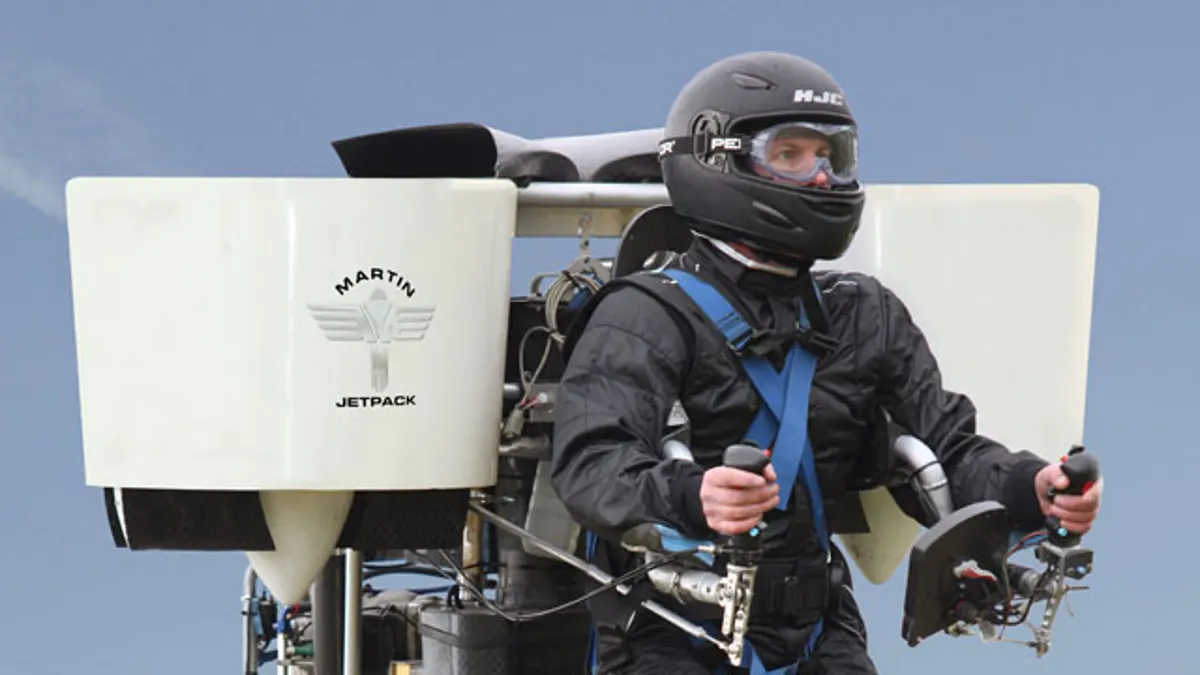
(Martin Aircraft Co.)
Martin Aircraft has spent 30 years honing its technology, but now the wait is over: The company just signed a $12 million joint-venture to start production of the world's first commercially available jetpack.
New Zealand's Martin Aircraft Company and an unnamed partner are gearing up to sell its jetpack: two rockets driven by a 2-liter, 200-horsepower engine that can theoretically take you as high as 8,000 feet.
The jetpacks would be sold to emergency response organizations, such as police and military, providing them with a quick way of getting aid and relief into disaster-hit areas. It was unlikely to have a direct military application but could be used in a troop-support role, said Martin chief executive Richard Lauder.
Martin expects to sell the devices to individual consumers late this year.
Lauder said the factory --located in an undisclosed country outside of New Zealand, where Martin is headquartered -- would build 500 units annually, generating $100 million per year for the company within three years.
"For us this is an excellent commercial step," he said. "We have somebody who is willing to put $12m on the table because they believe there is a sizeable market in their country."
With a range of 31 miles and a maximum speed of 63 miles per hour, Martin jetpack users will be able to jaunt to the store at will, or to the gas station for a fill-up. That's right, Martin's jetpack uses ordinary gasoline, not jet or rocket fuel.
The future is now, though it'll cost you around $100,000.
The Martin jetpack was designed to meet the Federal Aviation Administration's Part 103 regulations, which govern "ultralight" vehicles that don't require a pilot's license (though the company does require you to enroll in its training class prior to flying).
The FAA dictates that you won't be able to fly at night -- jetpacks are allowed only from dawn to dusk. But that's OK: The Martin jetpack doesn't have any operating lights.
The FAA also wags its finger at flying in town, warning that "no person may operate an ultralight vehicle over any congested area of a city, town, or settlement, or over any open air assembly of persons." And a slew of complicated regulations dictate how high you can fly, based on the visibility of clouds.
So owning a jetpack won't all be fun and games if the FAA ultralight regulations apply. If not, anything goes.
There's one more perk to flying over driving: You won't have to insure your jetpack. In fact, you probably won't even be able to. Companies like Avemco, which offers direct-to-customer insurance for private aircraft owners, have no plans to step into jetpack insurance.
Mike Adams, an underwriter for the company, notes that only four or five states require liability insurance to register and operate a private plane. The majority of owners of private aircraft do insure their vehicles anyway, just as they would a car, he explains. But how people will do that for jetpacks, or how the FAA will respond, is an open question.
"It's neither fish nor fowl. Is this regulated by the FAA or is it a personal vehicle like a bicycle or ATV? I don't think anyone knows yet," Adams mused.
What about the neighbors? You're not supposed to fly an ultralight vehicle over "congested areas," but what about in your backyard? And what about in a small town or a more rural city? That could be out, according to FAA regulations, though how they would monitor backyard flight is unclear.
Bottom line ... if you're the one with the jetpack, good news! If it's your neighbor, convince him that his flight path shouldn't be over your house. In either case, the future looks very fun indeed.
